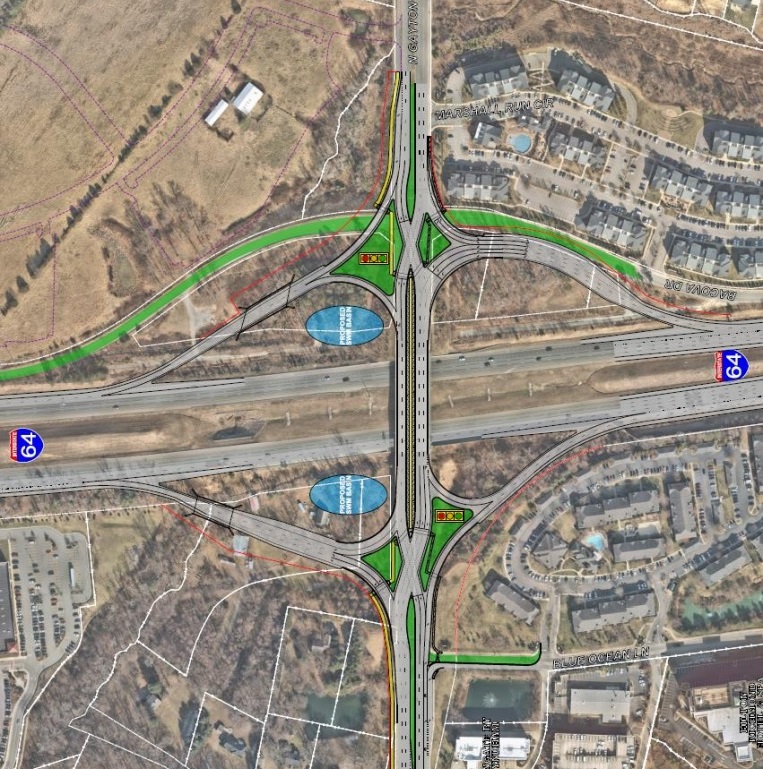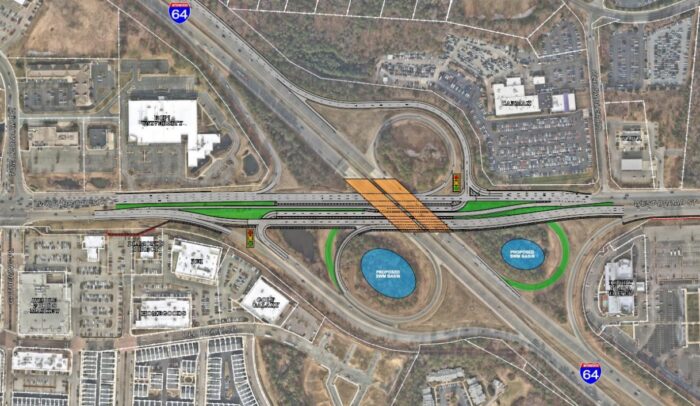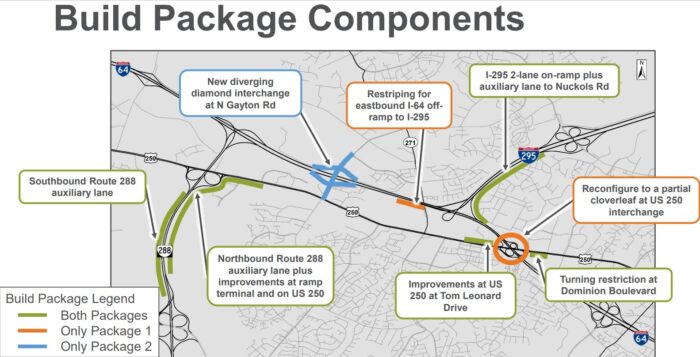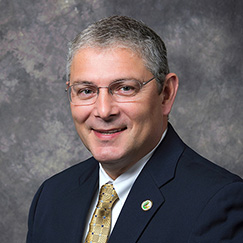
The diverging diamond interchange planned for Interstate 64 at North Gayton Road. (Henrico County images)
The latest push for a long-sought interchange and other traffic improvements for Short Pump is inching forward.
The Virginia Department of Transportation has endorsed a Henrico County plan to address interstate backups and congestion along Broad Street by way of a new interchange at I-64 and Gayton Road and modifications to existing roads and facilities, including to the Broad Street interchange between Short Pump and Innsbrook.
In an update to county supervisors this week, Henrico Public Works Director Terrell Hughes reported that the two-pronged approach received support from the public in an online survey and from VDOT, which has forwarded the proposal to the Federal Highway Administration (FHWA) with a recommendation for approval.
Hughes said the county has received FHWA’s initial comments on the plan and described them as “very minor.” Engineering firm Kimley-Horn was the county’s consultant on the plan.
“We have a meeting with VDOT in a couple weeks to hash out those comments, and then we’re hoping to hear some positive news from FHWA pretty soon so that we can start design and the environmental study,” Hughes told the supervisors.
The report was welcome news to the board, particularly to Three Chopt Supervisor Tommy Branin, who has been driving this latest push for a Gayton Road interchange that county officials have been seeking for more than two decades.
While the Gayton interchange remains the top priority, the county’s plan has evolved to include additional lanes and modifications to parts of Broad Street and the highways, and for a reduction of the cloverleaf interchange at Broad that would remove the on-ramp from its southeast quadrant.

Improvements to the 64-Broad Street interchange would include eliminating the southeast quadrant onramp.
Doing so would remove traffic from Broad merging into highway traffic, which has been contributing to backups for the westbound off-ramp to Short Pump. Hughes said that slowdowns there have contributed to numerous crashes, some of them fatal, and that backups are not only commonplace but increasing.
County traffic projections show that if no improvements are made to that interchange, and if the Gayton interchange isn’t added, backups for that exit could stretch as far as the Glenside Drive interchange by 2046.
“The conditions are expected to get worse in the future if nothing is done,” Hughes said. “If we don’t do anything in the Short Pump area, that’s how bad traffic would get: You would see a long queue of traffic that backed all the way to Glenside, potentially even further. And that’s under normal operating conditions.”
With the southeast quadrant on-ramp removed, eastbound traffic on Broad would access Interstate 64 west by way of a dedicated, signalized lane to turn left onto the northeast quadrant on-ramp that runs beside CarMax and currently serves westbound traffic from Broad.
The Gayton Road interchange would be a diverging diamond design, in which travel lanes temporarily cross sides in a manner meant to facilitate traffic flow. Hughes said VDOT prefers the design, which involves fewer signals and facilitates pedestrian and bicycle crossings. Hughes noted that a diverging diamond has been installed at the Zion Crossroads interchange near Charlottesville.
“It’s very innovative. It allows traffic to more easily get on and off the interstate,” he said.
Hughes noted that right-of-way for parts of the Gayton interchange on-ramps has been dedicated with the county’s approval of Avenlea, Markel | Eagle Partners’ 1,600-home development that’s planned northwest of the current Gayton bridge crossing. He said some additional right-of-way would be needed for a ramp in the northeast quadrant.
Other desired improvements include a two-lane on-ramp from 64 west to Interstate 295 eastbound, with an additional lane from there to the Nuckols Road interchange. Additional lanes and ramp expansions also are envisioned for Route 288 near its Broad Street interchange in Goochland County, where backups also are frequent.
“We’ve been partnering closely with Goochland, because 288 in Goochland interacts with I-64,” Hughes said, adding that Goochland has secured funding for some of those improvements. “There’s a little interplay there with traffic coming from 64 headed south that if not addressed could potentially back up through Henrico County.”
Areawide, a study found that over a five-year period through last fall, more than 1,800 crashes were reported on 64 and Broad from the Goochland line to as far east as Gaskins Road. Seven crashes were fatal and nearly 500 caused injury, and there were roughly 9,500 calls for service in that time.
Having previously worked in a statewide role at VDOT, Hughes told the board, “I don’t recall another quarter, or even like Northern Virginia, that had crash patterns like this. The No. 1 issue out there around Short Pump is safety. There’s also congestion.”
A county survey that generated 3,600 responses and more than 6,000 site visits revealed that the public most supported Henrico pursuing both the Gayton and 64-Broad interchange projects. Hughes said the projects would be phased, with the Gayton interchange completed first.
If FHWA signs off on the plan in coming weeks, next steps include design and environmental studies, which Hughes said are funded and would likely primarily require additional sound walls along affected highway sections.
Financing for construction would come later, involving a mix of county, state and federal funds. Hughes said the Gayton interchange is projected to cost $150 million, and the 64-Broad improvements are projected at $170 million. Combining both projects would bring the total to $250 million, with some overlap in the improvements, he said.
Hughes said that the design and environmental studies would be a two- to three-year process, and that construction on Gayton could start in three to four years if work goes as anticipated and funding falls into place.
County Manager John Vithoulkas, who has said funding Gayton is a top priority for the county, stressed the need for the projects in light of the traffic projections that put backups for Short Pump to as far as Glenside, with a projected wait time of 19 minutes.
“The average travel time in our region is roughly 22, 23 minutes,” Vithoulkas said. “That kind of delay on 64 headed west would not just be detrimental to Henrico” but to Goochland and beyond, he said.
Of the projects moving forward, Vithoulkas told the board, “Being able to get it out of VDOT, I think, was the largest hurdle.” After fielding the FHWA’s comments, he added, “Then we will start talking about the funding aspect and the timing of this all going into place.”

The diverging diamond interchange planned for Interstate 64 at North Gayton Road. (Henrico County images)
The latest push for a long-sought interchange and other traffic improvements for Short Pump is inching forward.
The Virginia Department of Transportation has endorsed a Henrico County plan to address interstate backups and congestion along Broad Street by way of a new interchange at I-64 and Gayton Road and modifications to existing roads and facilities, including to the Broad Street interchange between Short Pump and Innsbrook.
In an update to county supervisors this week, Henrico Public Works Director Terrell Hughes reported that the two-pronged approach received support from the public in an online survey and from VDOT, which has forwarded the proposal to the Federal Highway Administration (FHWA) with a recommendation for approval.
Hughes said the county has received FHWA’s initial comments on the plan and described them as “very minor.” Engineering firm Kimley-Horn was the county’s consultant on the plan.
“We have a meeting with VDOT in a couple weeks to hash out those comments, and then we’re hoping to hear some positive news from FHWA pretty soon so that we can start design and the environmental study,” Hughes told the supervisors.
The report was welcome news to the board, particularly to Three Chopt Supervisor Tommy Branin, who has been driving this latest push for a Gayton Road interchange that county officials have been seeking for more than two decades.
While the Gayton interchange remains the top priority, the county’s plan has evolved to include additional lanes and modifications to parts of Broad Street and the highways, and for a reduction of the cloverleaf interchange at Broad that would remove the on-ramp from its southeast quadrant.

Improvements to the 64-Broad Street interchange would include eliminating the southeast quadrant onramp.
Doing so would remove traffic from Broad merging into highway traffic, which has been contributing to backups for the westbound off-ramp to Short Pump. Hughes said that slowdowns there have contributed to numerous crashes, some of them fatal, and that backups are not only commonplace but increasing.
County traffic projections show that if no improvements are made to that interchange, and if the Gayton interchange isn’t added, backups for that exit could stretch as far as the Glenside Drive interchange by 2046.
“The conditions are expected to get worse in the future if nothing is done,” Hughes said. “If we don’t do anything in the Short Pump area, that’s how bad traffic would get: You would see a long queue of traffic that backed all the way to Glenside, potentially even further. And that’s under normal operating conditions.”
With the southeast quadrant on-ramp removed, eastbound traffic on Broad would access Interstate 64 west by way of a dedicated, signalized lane to turn left onto the northeast quadrant on-ramp that runs beside CarMax and currently serves westbound traffic from Broad.
The Gayton Road interchange would be a diverging diamond design, in which travel lanes temporarily cross sides in a manner meant to facilitate traffic flow. Hughes said VDOT prefers the design, which involves fewer signals and facilitates pedestrian and bicycle crossings. Hughes noted that a diverging diamond has been installed at the Zion Crossroads interchange near Charlottesville.
“It’s very innovative. It allows traffic to more easily get on and off the interstate,” he said.
Hughes noted that right-of-way for parts of the Gayton interchange on-ramps has been dedicated with the county’s approval of Avenlea, Markel | Eagle Partners’ 1,600-home development that’s planned northwest of the current Gayton bridge crossing. He said some additional right-of-way would be needed for a ramp in the northeast quadrant.
Other desired improvements include a two-lane on-ramp from 64 west to Interstate 295 eastbound, with an additional lane from there to the Nuckols Road interchange. Additional lanes and ramp expansions also are envisioned for Route 288 near its Broad Street interchange in Goochland County, where backups also are frequent.
“We’ve been partnering closely with Goochland, because 288 in Goochland interacts with I-64,” Hughes said, adding that Goochland has secured funding for some of those improvements. “There’s a little interplay there with traffic coming from 64 headed south that if not addressed could potentially back up through Henrico County.”
Areawide, a study found that over a five-year period through last fall, more than 1,800 crashes were reported on 64 and Broad from the Goochland line to as far east as Gaskins Road. Seven crashes were fatal and nearly 500 caused injury, and there were roughly 9,500 calls for service in that time.
Having previously worked in a statewide role at VDOT, Hughes told the board, “I don’t recall another quarter, or even like Northern Virginia, that had crash patterns like this. The No. 1 issue out there around Short Pump is safety. There’s also congestion.”
A county survey that generated 3,600 responses and more than 6,000 site visits revealed that the public most supported Henrico pursuing both the Gayton and 64-Broad interchange projects. Hughes said the projects would be phased, with the Gayton interchange completed first.
If FHWA signs off on the plan in coming weeks, next steps include design and environmental studies, which Hughes said are funded and would likely primarily require additional sound walls along affected highway sections.
Financing for construction would come later, involving a mix of county, state and federal funds. Hughes said the Gayton interchange is projected to cost $150 million, and the 64-Broad improvements are projected at $170 million. Combining both projects would bring the total to $250 million, with some overlap in the improvements, he said.
Hughes said that the design and environmental studies would be a two- to three-year process, and that construction on Gayton could start in three to four years if work goes as anticipated and funding falls into place.
County Manager John Vithoulkas, who has said funding Gayton is a top priority for the county, stressed the need for the projects in light of the traffic projections that put backups for Short Pump to as far as Glenside, with a projected wait time of 19 minutes.
“The average travel time in our region is roughly 22, 23 minutes,” Vithoulkas said. “That kind of delay on 64 headed west would not just be detrimental to Henrico” but to Goochland and beyond, he said.
Of the projects moving forward, Vithoulkas told the board, “Being able to get it out of VDOT, I think, was the largest hurdle.” After fielding the FHWA’s comments, he added, “Then we will start talking about the funding aspect and the timing of this all going into place.”






Just reconfiguring this interchange and tweaking a few roads will cost $250 million—roughly 5 times the cost of the entire Pulse BRT system. This will contribute to sprawl and environmental degradation in central VA, and even if road safety is improved from the appalling 1,800 crashes and multiple deaths in the area in the last five years, it will still be far more dangerous than public transit which is consistently shown to be safer than driving. If anyone needs more evidence of how misguided our spending priorities are on public transit v. automobile infrastructure, here it is. But this will… Read more »
Public transportation maybe a thing of the future for central VA,but I’m guessing in 150 yrs from now.Roads need upgrading according to growth in any area that have the development that Short Pump has seen in the last 25 yrs.
Best thing they could do is start making the driving tests along stricter and more challenging in the state. There are too many folks on the road now that have no respect for others and are definitely not responsible enough to have a motor vehicle. You would see major improvements if our tests started being more like Germanys.
Dang it autocorrect :/.
Edit and vote buttons are broken too.
An extension of the Pulse to Short Pump would be very beneficial imo. Creating safe and efficient transportation Alternatives is important. If the pulse is extended, bus lanes are crucial and I’m not sure how Henrico feels on that topic.
Let’s make what is already done start working FIRST without tripling-down…
Not sure what you mean. The Pulse is already one of the most successful bus rapid transit systems in the U.S.
https://www.virginiamercury.com/2022/11/23/richmonds-pulse-has-been-a-surprise-success-other-cities-and-states-are-taking-notice/
The reason the Pulse may be “the most successful” is because it is free to use, and the FEDS paid for most, if not all of the Pulse costs. Our regional 3-6 counties are not going to pay for this expansion themselves. Additionally, the Pulse model will not work for Moseley and Short Pump dwellers to commute to work downtown. The Pulse literally stops every 3-5 blocks. From Moseley, It would take approx. 90 minutes (or more) one way to get to work.
To fix the Broad Street and 64 interchange, look to the Gaskins interchange. Why wouldn’t they expand the feeder lanes from Gaskins all the way to 295 – or even 288? Feeder lanes would greatly impact the Broad Street interchange for the better! If you look at what F’burg did, the Feeder lanes really helped keep the traffic flowing, and reduced the backup onto 95.
The other thing that drives me crazy is when they design roads that will not let you get on and off at the same interchange. But at least they are doing something!
Ms. Woodville, while I envy the amount of downvotes you get here you seem to be getting many entirely on a reservoir of ill-will —- I see nothing in your comment here that seems offensive or even controversial, unless there has to be some kind of anti-car sentence inserted to generally not earn a downvote or ten.
Are traffic backups good now? Feeder-lanes maybe racist? What?
Ha! I love you……! Spot on Shawn – haters are gonna’ hate.
I have heard these diverging diamond interchanges being touted as a way to improve traffic flow. I don’t understand how. Every one I’ve seen, the traffic moving across the overpass seems to have to stop more frequently (and longer) than it would with a conventional interchange. Maybe someone can explain the benefits to me.
Those big peanut shaped roundabout interchanges have always been better in my opinion. VDOT is actually planning on putting one at the Willis Rd interchange for I95.
I have no idea, but just from a land mass perspective, cloverleafs take up a ton of real estate, and real estate in Short Pump is at a premium.
They built one of these in Stafford. The result? More people have to stop at lights, and people who don’t use it regularly get really confused. That’s it.
That’s the one I was thinking of that didn’t give me a real favorable impression. On a side note, I thought I recall that interchange being somewhat rural the last time I accessed it (10, 15 years ago?) to get gas. So when I supposed to exit at it last year, I blasted right past it because it looks nothing like it used to.
It’s going to take 14 months to re-place the deck of the Pemberton Road bridge across I-64. I can’t imagine how many years it will take to complete the Short Pump/Gayton Road work. VDOT, as well as the Federal Government, work at a snail’s pace.
but, but, “it’s shovel ready!….” Frankly, I’m waiting for the toll to come……governments LOVE tolls.
Isn’t this similar (at Broad and 64) to what the did at the airport exits. No more cross over on and off ramp traffic at the worst choke points. I think it worked at Airport but that does have less overall traffic. Maybe with the new Gayton exit option and the improvements at 288 they just might help keep back ups from getting worse.
Light rail from Broad and 288 to downtown; from Westchester Commons to downtown, and then out to the airport. Traffic problems solved. Face it, it will have to happen eventually, let’s start it now!
Shucks,I won’t be able to drive my new ev downtown?
Don’t say “light rail”….Richmond translates that into Pulse lines.
Realistically, you’d need a hub-and-spoke model light rail that circles and intersects the city on multiple routes for it to have a meaningful impact on traffic in the RVA area. Unfortunately, that’s too cost prohibitive.
So; it will take another 3+ years to get this planned and budgeted so possibly another 3-5 people will die in that period of time based on the accident data collected. It’s nice to see how VDOT values the lives of others. While we are at it let’s build some more shopping centers and housing developments along whatever ground is left on Broad Street to just increase the fatality data. What’s amazing is if everyone would actually get their heads out of their A_ _ you could solve this problem and build it in less time and have less funerals.
What’s ironic in this entire conversation is that I believe at one time when the mall was being planned there was going to be a dedicated exit, not sure if it was on North Gayton or further up right into the mall. If I remember correctly the owners of Regency threatened to sue saying that public money was being spent to support the new mall. It would have been much better if they would have built that exit way back when.
Per the link in the article, 2,000 new homes are/were proposed across three projects in Short Pump (including the 1600 by Markel | Eagle Partners quoted in this article). Just a thought, but maybe Henrico should slow down the rate of development (and environmental deforestation and traffic impact) in the Short Pump area. Oh, wait, there’s a huge amount of money to be made by all involved. Henrico’s County’s motto: Develop first and push the associated problems (traffic, overcrowded schools, affordable housing, etc., etc., etc.) down the road. Never mind. Slowing development is way too reasonable an idea.